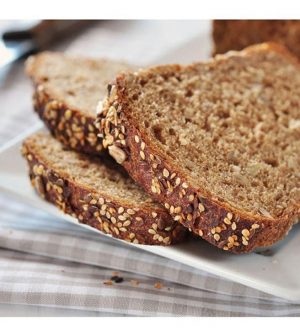- Skip Storing This Everyday Product in the Fridge Door
- Green Tea + B3 Pairing May Boost Brain Health
- Navigating Your Midlife Crisis: Embracing New Possibilities
- City Raccoons Showing Signs of Domestication
- Mapping the Exposome: Science Broadens Focus to Environmental Disease Triggers
- One Week Less on Social Media Linked to Better Mental Health
- Your Brain Changes in Stages as You Age, Study Finds
- Some Suicide Victims Show No Typical Warning Signs, Study Finds
- ByHeart Formula Faces Lawsuits After Babies Sickened With Botulism
- Switch to Vegan Diet Could Cut Your Greenhouse Gas Emissions in Half
Whole Grains Every Day: Key to Your Health and Waistline

Whole grains can help older adults maintain a thinner waist, lower blood pressure and lower blood sugar, new research suggests.
Just three servings a day may do the trick, the authors said.
One serving is a slice of whole-grain bread, a half-cup of rolled oat cereal, or a half-cup of brown rice.
Researchers noted that their study — partially funded by the General Mills Bell Institute of Health and Nutrition — doesn’t prove that whole grains are protective, only that there appears to be a link between them and waist size, blood pressure and blood sugar.
“These are all risk factors that can contribute to the development of heart disease if not maintained at healthy levels,” said study co-author Nicola McKeown of the Nutritional Epidemiology Team at Tufts University’s Jean Mayer USDA Human Nutrition Research Center on Aging in Boston.
The researchers used data from a health study of residents in Framingham, Mass., which started in 1948. They looked at health outcomes linked to whole and refined grains in the diets of more than 3,100 participants. Data was collected every four years over a median follow-up of 18 years. (Median means half were followed longer, half for less time.)
The new study compared changes in five heart disease risk factors — blood pressure, blood sugar, cholesterol, triglycerides and waist size — with reported intake of whole grains. Researchers examined effects of eating less than a half-serving to three or more a day.
The upshot: People who ate few whole gains gained an inch around the waist every four years — compared to a half-inch among those who ate the most whole grains.
Participants who ate fewer whole grains also saw bigger increases in blood pressure and blood sugar than those who ate the most whole grains.
While whole grain intake was also associated with improvements in blood levels of HDL, or good, cholesterol, as well as triglycerides, the findings were not significant, researchers added.
For waist size, blood pressure and blood sugar, the greatest benefit came from having three to four servings of whole grains a day.
Most whole grains came from whole wheat breads and ready-to-eat cereals. Refined grains were mostly pasta and white bread.
McKeown said whole grains probably help prevent adverse changes in risk factors studied in several ways, but the mechanisms aren’t yet known.
“For instance, in terms of helping prevent gain in body fat, the benefits may be related to the fiber in whole grains, which can help to prevent post-meal blood sugar spikes, help us to feel full so that we might eat a little less, or even feed our healthy gut microbes,” she said.
Other nutrients found in whole grains, such as magnesium, may help with maintaining healthy blood sugar levels and blood pressure.
“And then we have the many phytochemicals found in whole grains that may act alone or in synergy with other nutrients to help maintain our health as we age,” McKeown said. “This is still a very active area of research.”
Samantha Heller, a senior clinical nutritionist at NYU Langone Health in New York City, was not part of the study but reviewed the findings. She said whole grains have many benefits.
“Fiber-rich foods like whole grains provide a plethora of healthy compounds like vitamins, minerals and antioxidants,” Heller said. “Research has found that whole grains help reduce body weight and low-grade inflammation, manage blood sugar, reduce the risk of certain cancers and keep the gastrointestinal tract running smoothly.”
But, Heller said, the typical Western diet consists primarily of refined grains, such as white bread, cereals, crackers, desserts and pastries. These refined grains have been found to increase the risk of heart disease, diabetes, certain cancers and even a decline in memory and thinking skills, she added.
The good news: Adding more whole grains to the diet is easier than you might think.
“Consumers may be surprised to realize that foods like tortilla chips, shredded wheat, oatmeal, whole wheat tortillas and whole-grain crackers all count as whole grains,” Heller said.
She said shoppers can look for the Whole Grain Council’s “Whole Grain” stamp on product labels. It identifies how many grams of whole grains are in a product.
The findings were published online July 13 in the Journal of Nutrition.
More information
For more on whole grains, see the Whole Grain Council.
SOURCES: Nicola McKeown, PhD, scientist, Nutritional Epidemiology Team, Jean Mayer USDA Human Nutrition Research Center on Aging, Tufts University, Boston; Samantha Heller, MS, RD, CDN, senior clinical nutritionist, NYU Langone Health, New York City; Journal of Nutrition, July 13, 2021, online
Source: HealthDay
Copyright © 2025 HealthDay. All rights reserved.










